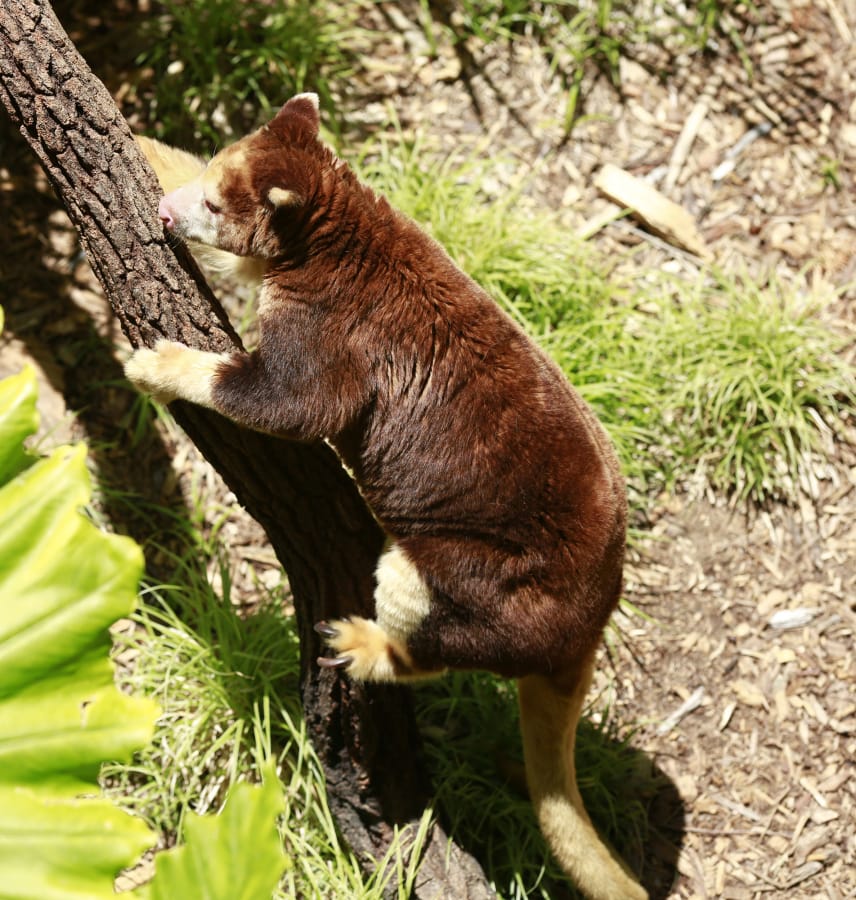SAN DIEGO — Wally’s blue tongue rapidly flickers in and out. She swivels her head toward the visitors, reptilian eyes bright.
Wally is a northern blue-tongued skink. These Australian lizards display their azure intakes appendage to ward off predators. Bright colors often mean danger, such as with the highly venomous blue-ringed octopus.
But no worries, blue-tongued skinks are harmless. The color display is all a bluff. Gently handled by keeper Benjamin Fan, Wally even permits a visitor to caress her supple, squamate skin.
The display of lingual lapis lazuli provides one of the intimate moments between human and animal at the Roos and Mates tour. It opened last year at the new Walkabout Australia attraction at the San Diego Zoo Safari Park.
Wally is one of several “animal ambassadors” guests might meet.
Even more intimately, those on the two-hour tour can offer leafy treats to kangaroos, which gently take them from your grasp.
Housed with Wally in an off-exhibit area for “animal ambassadors” is Adelaide, a red kangaroo. Adelaide jumped on request, and allowed a visitor to feed her with one hand, leaving the other free to stroke her dense, luxuriant fur.
You’re also allowed to feed the native Australian geese and ducks. They get dried millet, cricket and writhing giant mealworms that undulate uncomfortably between your fingers before you throw them to the ground.
And you also learn from a guide and keepers the general principles that allow such closeness. Animals willingly modify their behavior if given the right incentives, and well treated.
This is done by proven psychological methods such as operant conditioning. They get a reward for performing the desired behavior, or approximating it. If they don’t, nothing happens.
“If you respect animals, they’ll respect you,” said tour guide Aaron Weiss.
Tour guests also get instructions in animal etiquette. For example, when feeding the kangaroos, always leave them an escape route.
But even etiquette has its limits. No such direct contact is allowed with another colorful Australian native, the cassowary.
Two of these velociraptorian-style giant birds are on display, both males. (Two females are kept out of sight; the plan is to breed them.) Each cassowary foot has a daggerlike claw that can, and has, killed people.
Safely behind fencing, the cassowaries stalk around their green habitat, displaying their red and blue wattles and piercing light brown avian eyes.
Two refrigerators face each other inside the marsupial care building’s kitchen. One is labeled as containing animal food, the other human food.
The animals arguably have the better of the deal, says Weiss, the tour guide.
“Does anybody here have a nutritionist?” Weiss asks the group. “These animals have three. So these guys get a higher-quality diet on a daily basis than we’re getting ourselves.”
On a wall is a diet sheet for each animal, listing the food type, and the amount or grams in their meals. And like chefs for humans, the animal caregivers like to get a little creative in how they present the meals. Weiss pulls out a bowl of ice topped with apples slices — an apple popsicle.
Further inside are two rooms facing an enclosure for a rare kangaroo species, Matschie’s tree kangaroo. As the name implies, these smallish kangaroos are at home in trees. Found in the mountain forests of New Guinea, these tree kangaroos are classified as endangered on the International Union for the Conservation of Nature’s Red list.
They’re mostly dark brown, with creamy paws and faces, topped with pink noses. Cuteness quotient: Near panda-level.
The rooms are sleeping and indoor quarters for two of the tree kangaroos, one for Spike, a nearly 6-year-old male, and Polly, a 3-year-old female. They can have controlled access to a “dating” room between their quarters, said mammal keeper Bree Barney.
Spike is outside today.
Inside her quarters, Polly remains quiet and immobile. Just when a visitor concludes she’s one of the toys inside the branch-bedecked interior, she moves slightly.
Polly may be pregnant, as she was introduced to Spike earlier this year.
“We had an introductory session between the two and it went very, very well,” Barney said.
Another unique species may soon be breeding, the echidna, or spiny anteater, cousin to the duck-billed platypus.
Plans are to introduce Shaw, a male echidna animal ambassador, to a female.



